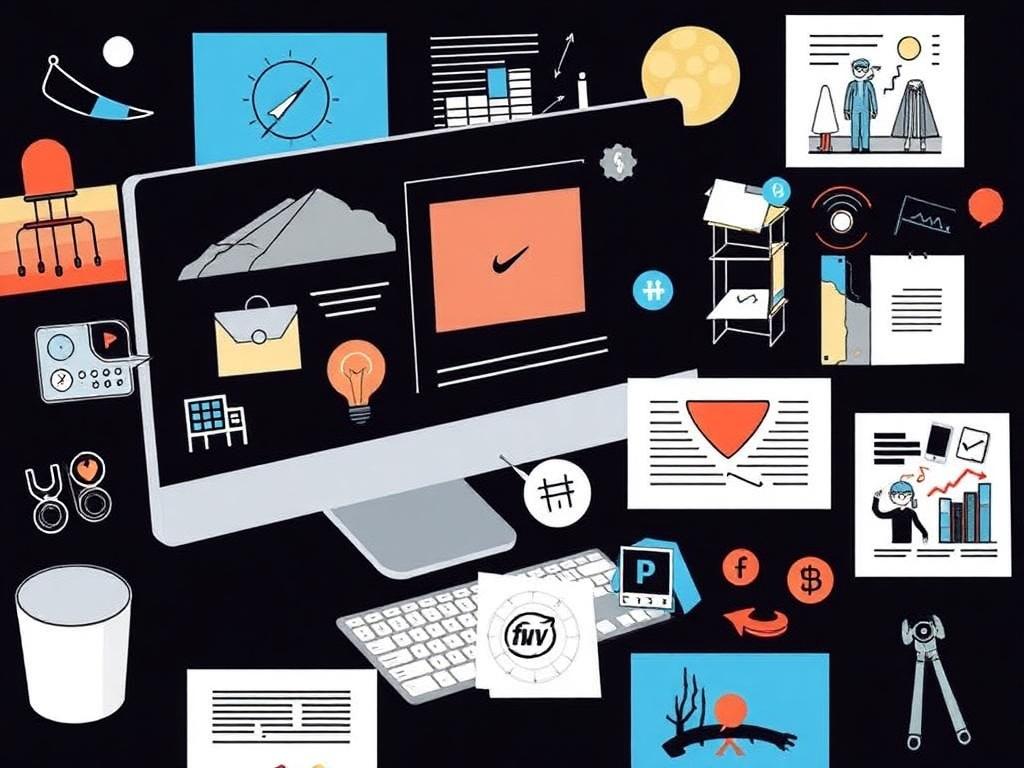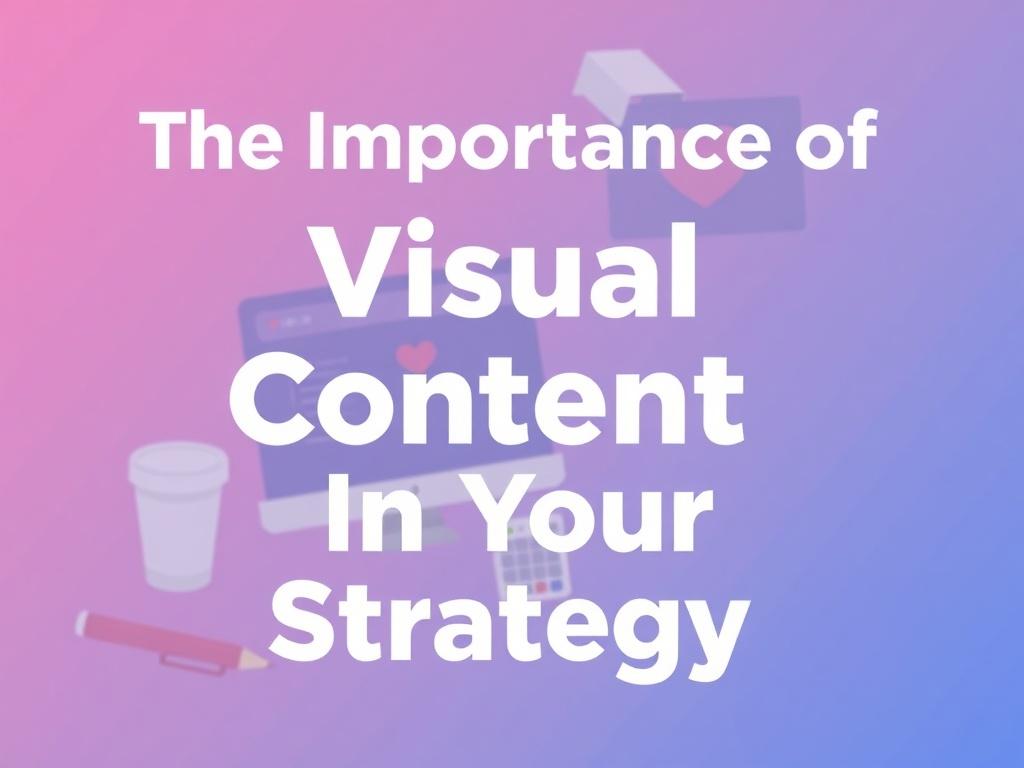Visual content isn’t just a nice-to-have ornament on your website or social feed. It’s the fuel that powers attention, comprehension, and emotion in a world overflowing with words. Think about the last time you scrolled through your phone: what caught your eye first — a wall of text or a striking image or short video? If you’re reading this, you’re already leaning toward the visual. This article will walk you through why visual content deserves center stage in your strategy, how to create it effectively, and how to measure its real impact. We’ll cover principles, tools, and practical steps so you can leave with ideas you can use tomorrow.
Why Visual Content Matters Now More Than Ever
We live in an era of shrinking attention spans and unlimited choice. People decide in seconds whether to keep scrolling or stop. Visuals help you win those precious seconds. Images, videos, and interactive elements make information digestible, memorable, and emotionally resonant. They break up complexity and invite action.
People process visuals faster than text. Neuroscience shows the brain can interpret images in as little as 13 milliseconds. That speed translates to real-world outcomes: higher click-through rates, longer time on page, better social sharing, and stronger brand recall. When visuals are aligned with your message, they create shortcuts to understanding that words alone can’t match.
Visuals as trust builders and memory anchors
A well-crafted visual conveys professionalism and care. A branded image or a crisp explainer video signals that you invest in your audience’s experience. Visuals also anchor memory: people remember what they see far better than what they read. That’s why important data is often turned into charts, infographics, or short animations — visuals give numbers a narrative.
The social dimension: why visuals perform better on platforms
Social platforms are optimized for visuals. Algorithms reward engagement, and visuals generate more likes, comments, and shares than plain text. Instagram, TikTok, and Pinterest are visual-first by design, but even text-heavy platforms like Twitter (now X) and LinkedIn see higher engagement when images or videos accompany posts. If your strategy doesn’t prioritize visuals, you’re leaving reach and resonance on the table.
Types of Visual Content and When to Use Them
Not all visual content is created equal. Different formats serve different goals — education, inspiration, conversion, or retention. Below is a practical guide to common visual types and ideal use cases.
Image-based content
High-quality photos and branded graphics are the backbone of many campaigns. Use images when you want to:
- Showcase products
- Create aspirational or lifestyle associations
- Complement written content with relevant visual cues
Images are versatile and quick to produce, especially with smartphone cameras and editing apps.
Infographics
Infographics distill complex information into a compelling narrative. They’re ideal for:
- Data-driven stories or industry reports
- Step-by-step guides
- Educational content that benefits from visual hierarchy
A great infographic makes a dense topic scannable and shareable.
Video content
Video is the most engaging format for storytelling. Use it for:
- Product demos and tutorials
- Customer testimonials and case studies
- Brand stories and behind-the-scenes content
Short-form videos (15–60 seconds) excel on social platforms, while longer-form videos deepen engagement on websites or YouTube.
Animations and GIFs
Small animations add personality and clarify motion or process. GIFs and micro-animations work well in emails, calls-to-action, and social posts to draw attention without demanding a long watch time.
Interactive visuals
Interactive charts, quizzes, and maps invite active participation. Use them to:
- Personalize content experiences
- Increase time on page
- Collect first-party data (with consent)
Data visualizations
Charts and dashboards turn numbers into insight. They’re essential for:
- Reporting results
- Showing trends and comparisons
- Making evidence-based arguments
Quick comparison table: visual types and best scenarios
| Visual Type | Best For | Ideal Platform | Production Effort |
|---|---|---|---|
| Photographs | Product display, lifestyle imagery | Website, Instagram, ads | Low–Medium |
| Infographics | Educational content, reports | Blog posts, LinkedIn, SlideShare | Medium |
| Short Video | Engagement, tutorials, ads | TikTok, Instagram Reels, YouTube Shorts | Medium |
| Long-form Video | Deep dives, storytelling | YouTube, website | High |
| Animations/GIFs | Micro-storytelling, UI hints | Social, product pages | Low–Medium |
| Interactive Visuals | User personalization, engagement | Website, microsites | High |
Psychology Behind Visual Content

To use visuals effectively, you need to understand why they work. The psychology of visual perception, memory, and emotion explains much of the advantage visuals bring.
Attention and cognitive load
Visuals reduce cognitive load by turning abstract ideas into concrete forms. This helps users quickly understand what matters. Clean design, clear focal points, and minimal distractions guide attention where you want it.
Emotion and storytelling
Images and videos elicit emotions faster than text. An image of a happy customer or an evocative color palette can trigger empathy and trust. Emotion drives action; when someone feels something, they’re more likely to engage, share, or buy.
Memory and recall
The pictorial superiority effect means people remember images better than words. Combine a memorable visual with a short, succinct message, and you’ll significantly increase recall.
Crafting a Visual Content Strategy
Creating visuals at scale requires planning. Random acts of content won’t build a cohesive brand experience. Below are core elements to include in a visual content strategy.
Define your goals and audience
Start with clarity. Are you trying to build awareness, drive clicks, nurture leads, or support customers? Define target audience segments: what visuals do they respond to? Different age groups and platforms have distinct expectations.
Establish brand visual guidelines
Consistency matters. Create a visual style guide covering:
- Color palette
- Typography rules
- Logo usage
- Photography style
- Illustration types
A guide ensures every visual reflects your brand identity, whether created in-house or by an agency.
Create a content calendar and workflow
Plan visuals around campaigns, product launches, and seasonal moments. Define a production workflow with roles, deadlines, and approval steps so visuals move from concept to publish without chaos.
Balance evergreen and timely content
Evergreen visuals (how-to videos, foundational infographics) deliver long-term value. Timely visuals capitalize on trends and news cycles. Aim for a mix to keep your feed relevant and durable.
Repurpose and adapt
One core visual can be recycled across channels. A webinar can become short videos, quote cards, and an infographic. Repurposing multiplies value and reduces production costs.
Visual content strategy checklist
- Set measurable goals (KPIs) for visual content
- Create a visual brand style guide
- Map visuals to buyer journey stages
- Plan a content calendar with production timelines
- Choose tools and allocate budget
- Define measurement and reporting methods
Production: Tools, Teams, and Budgets
You don’t need a Hollywood budget to produce great visuals, but you do need the right tools and processes.
Low-budget to pro-level tools
Here’s a helpful table comparing common tools and their best uses.
| Tool | Best For | Skill Level | Cost |
|---|---|---|---|
| Smartphone camera + editing apps | Quick photos, short videos | Beginner | Low |
| Canva | Templates, graphics, social posts | Beginner–Intermediate | Low–Medium |
| Adobe Photoshop/Illustrator | Advanced image and vector work | Advanced | Medium–High |
| Premiere Pro / Final Cut | Professional video editing | Advanced | Medium–High |
| Figma / Sketch | UI, prototyping, collaborative design | Intermediate–Advanced | Medium |
| Visme / Piktochart | Infographics and presentations | Beginner–Intermediate | Low–Medium |
| Interactive tools (e.g., Flourish, Tableau Public) | Interactive charts and visualizations | Intermediate | Low–High |
Deciding between DIY and agency
If visuals are occasional, DIY with templates may suffice. If visuals are core to your brand (daily social content, product videos, interactive reports), consider hiring specialists or an agency. Hybrid approaches — in-house creators with agency support for big projects — often offer the best balance.
Budgeting for visual content
Allocate budgets by impact: hero projects (large videos, flagship reports) get higher spend, while social content uses templated production. Track ROI to justify and refine budgets over time.
Design Principles That Make Visuals Work
Good visuals rely on fundamentals of design. Even simple assets look professional when basic principles are applied.
Hierarchy and focal points
Use size, color, and contrast to guide the eye. Every visual should have a clear focal point that communicates the primary message in an instant.
Contrast and color
Contrast improves readability and draws attention. Use your brand palette consistently but allow complementary colors for emphasis. Understand color psychology — different hues evoke different feelings.
Typography
Choose readable fonts and maintain typographic hierarchy (headlines, subheads, body text). Limit font families to preserve consistency.
White space and simplicity
Don’t overcrowd visuals. White space improves clarity and perceived value. Minimalist designs often appear more sophisticated and are easier to consume.
Consistency
Consistent visual language builds recognition. Apply consistent filters, icon sets, and layout templates to reinforce brand identity.
Accessibility and Inclusivity

Effective visual content isn’t just pretty — it’s accessible to as many people as possible.
Alt text and descriptive captions
Always include alt text for images. Use concise, descriptive captions that help screen reader users understand the visual context. Alt text is also valuable for SEO.
Closed captions and transcripts
Provide captions for videos and transcripts for longer audio. Many viewers watch videos muted, and captions increase comprehension and engagement across the board.
Color contrast and readability
Ensure sufficient color contrast for text and critical elements. Tools exist to test contrast ratios and meet accessibility standards like WCAG.
Design for different abilities
Avoid relying solely on color to convey meaning (use patterns or labels too). Offer keyboard navigation for interactive visuals and consider users with cognitive disabilities when designing complex interactions.
Measurement: How to Know What’s Working
If you can’t measure impact, you can’t improve. Visual content should be tracked against clear KPIs.
Key metrics to track
- Engagement rate (likes, comments, shares)
- Click-through rate (CTR) on visual CTAs
- Time on page for content with visuals
- View-through rate for videos
- Conversion rate (from visual-led campaigns)
- Social referral traffic
- Brand lift (surveys measuring awareness or recall)
Testing and iteration
A/B test thumbnails, color treatments, headlines, and video lengths. Small changes can produce big lifts. Use heatmaps and scroll maps to see how people interact with visuals on a page.
Attribution and multi-touch
Visual content often contributes to multi-touch journeys. Use multi-touch attribution models or assisted conversion reports to understand the visual content’s role in the funnel.
Repurposing Visual Content for Maximum Value
Repurposing extends the life of each asset and multiplies ROI. Think about every piece of content as raw material for multiple outputs.
Examples of repurposing
- Turn a research report into an infographic, a slide deck, and short social clips.
- Clip highlights from a webinar into short tutorials and quote cards.
- Create carousels for LinkedIn from long-form blog headers and data points.
- Convert customer testimonials into a video montage and image quotes.
Batch production
Batch-create visuals for a season or campaign. This reduces context switching and yields a coherent library of assets you can adapt quickly.
Case Studies and Real-World Examples
Theory is good, but examples show how visual content moves the needle. Below are abstracted case examples to illustrate typical outcomes.
Case Study A: SaaS Startup
A SaaS company produced short explainer videos for its top three features and optimized their landing page visuals. Results within three months:
- Landing page time on page increased by 45%
- Free trial signups increased by 22%
- Ad CTR improved by 30% with video thumbnails
Case Study B: Retail Brand
A retail brand invested in lifestyle photography and shoppable Instagram posts. Outcomes:
- Instagram engagement increased 60%
- Social referral revenue rose 35%
- Average order value increased due to better product presentation
Case Study C: B2B Thought Leadership
A B2B firm turned a whitepaper into an infographic series and interactive dashboard. Outcomes:
- Lead magnet downloads increased 3x
- Time on page for the report doubled
- The interactive dashboard generated inbound inquiries from enterprise prospects
Common Pitfalls and How to Avoid Them
Even well-intentioned visual programs can stumble. Here are common mistakes and how to fix them.
Pitfall: Overdesigning
Solution: Prioritize clarity. Remove unnecessary elements and focus on one message per visual.
Pitfall: Ignoring mobile
Solution: Design mobile-first. Check how visuals appear on small screens and consider vertical video formats.
Pitfall: Inconsistent branding
Solution: Create and enforce visual guidelines. Use templates to maintain consistency across teams.
Pitfall: Not measuring
Solution: Define KPIs before launching and use analytics to iterate.
Emerging Trends to Watch
The visual landscape is always shifting. Keep an eye on these trends that are shaping how brands connect.
Short-form vertical video dominance
TikTok and Reels have changed expectations for bite-sized, authentic videos. Brands that adapt to vertical formats and native platform styles win attention.
Augmented reality (AR) and virtual try-ons
Retail and beauty brands increasingly use AR to let customers try products virtually. AR reduces friction and increases conversions.
AI-assisted visuals
Generative AI can speed up ideation and production, from draft imagery to video storyboards. Use AI intelligently and always human-review output for accuracy, ethics, and brand fit.
Interactive and immersive experiences
Interactive stories, data experiences, and 3D visuals are becoming more accessible and impactful for high-value content.
Actionable Steps to Get Started Today
Ready to put visuals at the center of your strategy? Here are steps you can take this week.
Week 1: Audit and quick wins
- Audit your current visuals across channels and map top-performing assets.
- Identify 1–2 high-impact updates (better thumbnails, captions, or hero images).
- Create templates for social posts and email visuals to speed future production.
Week 2–4: Build the foundation
- Draft a basic visual style guide and share it with your team.
- Plan a 30–60 day content calendar with a mix of video, images, and infographics.
- Choose tools and set up production workflows with clear roles.
Month 2–3: Measure and iterate
- Run A/B tests on thumbnails, hero images, and short videos.
- Track KPIs and adjust creative based on performance.
- Repurpose top-performing content across multiple channels.
Resources and Tools
Below is a compact table of resources to help you build and manage visual content.
| Purpose | Tool/Resource | Why It Helps |
|---|---|---|
| Easy graphics & templates | Canva | Fast templates for social, web, and print |
| Professional image editing | Adobe Photoshop / Lightroom | Advanced photo manipulation and color grading |
| Video editing | Premiere Pro / Final Cut | Robust editing for long and short-form video |
| Infographics & presentations | Piktochart / Visme | Templates for reports and data visualization |
| Interactive charts | Flourish / Tableau Public | Create shareable interactive visuals |
| Stock assets | Unsplash, Pexels, Shutterstock | High-quality images and vectors |
| Accessibility testing | WebAIM Contrast Checker | Ensure color contrast meets standards |
Putting It All Together: A Practical Example
Imagine you’re launching a new product. Here’s a simple visual-first plan:
- Create a hero product video (30–60 seconds) that shows the product in use. Post as native video on social + embed on product page.
- Design a set of lifestyle photos to use in ads and on the website. Ensure alt text and captions are in place.
- Produce one infographic highlighting key specifications and benefits for the press kit and blog post.
- Repurpose the hero video into 4 short clips for social stories and Reels, and create quote cards from customer feedback.
- Track video view-through rate, CTR to product page, and conversion rate from social ads. Iterate visuals based on what drives the most conversions.
Final Checklist Before You Publish

- Does the visual align with your message and audience?
- Is the focal point clear within 2–3 seconds?
- Have you optimized for mobile formats?
- Is alt text and captioning included where applicable?
- Are brand guidelines applied consistently?
- Is there a clear call-to-action?
- Have you set up tracking and defined KPIs?
Conclusion
Visual content is no longer optional — it’s essential. When you prioritize visuals thoughtfully, you cut through the noise, build trust, and create memorable experiences that move people to act. Start small with a clear goal, use consistent visuals, measure what matters, and iterate. Over time, a visual-first approach will not only boost engagement and conversions but also shape a more compelling and human brand that people recognize and remember.